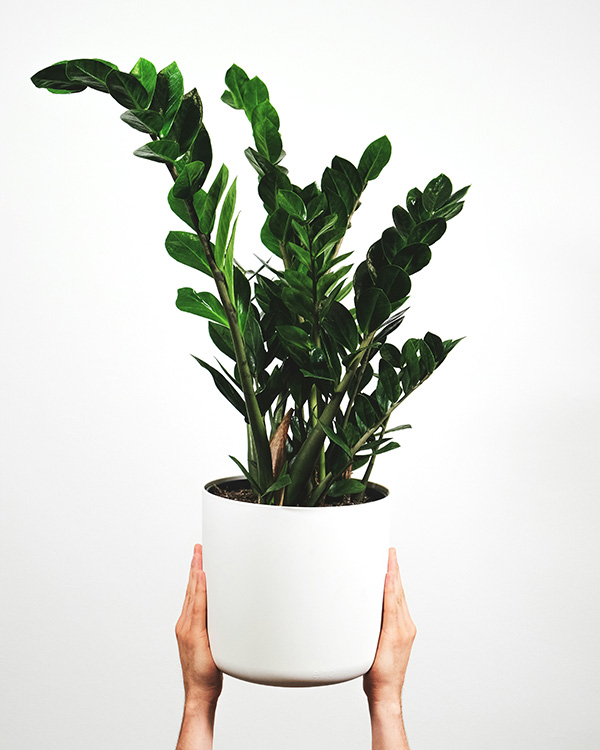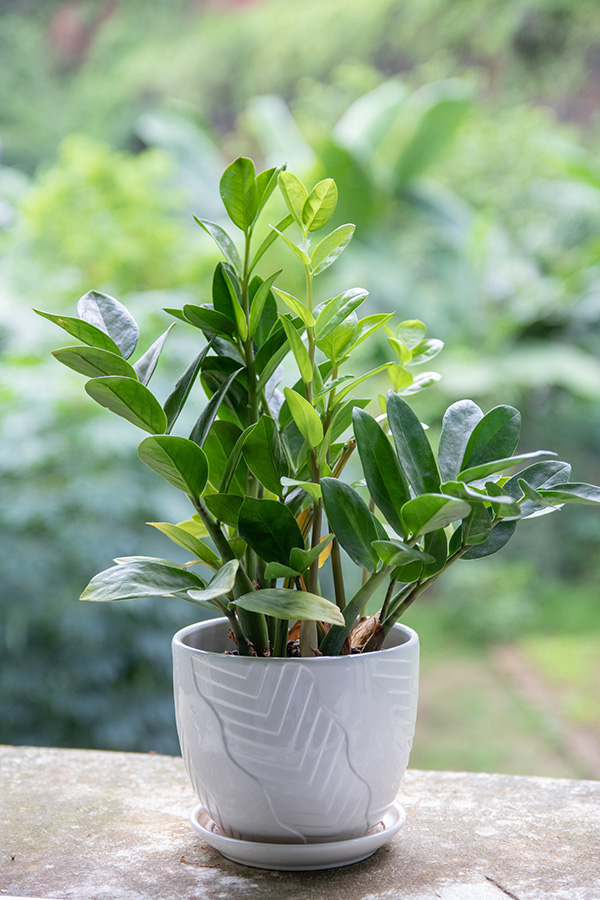ZZ plants, known scientifically as Zamioculcas zamiifolia, have soared in popularity among plant parents, and it's easy to see why. These sleek, stylish indoor plants are not only Instagram-worthy with their waxy, verdant leaves but are also famously resilient, making them ideal for both the green-thumbed enthusiast and the forgetful waterer.
In this guide, we dive into the essentials of ZZ plant care. Whether you're a seasoned plant parent or just starting your indoor jungle, we've got the lowdown on keeping your ZZ thriving. Spoiler alert: it's simpler than you think. So, let's get into the roots of what makes the ZZ plant a must-have in your space and how to keep it looking effortlessly chic.
Botanical Name
Common Name
Plant Type
Mature Size
Sun Requirement
Soil Type
Hardiness Zone
Pet Friendly
Zamioculcas zamiifolia
ZZ plant
Perennial
2-4 ft. tall, 2-4 ft. wide
Partial
Well-draining
9-10 USDA
No
What is a ZZ Plant
The ZZ plant, scientifically known as Zamioculcas zamiifolia, is a perennial plant that originates from eastern Africa and thrives in tropical environments. Known for its wide, dark green foliage, it's a popular choice for indoor environments due to its low maintenance needs and ability to thrive in low-light conditions.
The resilient nature of this foliage plant makes it well-suited for owners with busy or forgetful tendencies, as it can withstand neglect and irregular watering. Its air-purifying qualities add to its appeal, as it can help remove toxins from indoor spaces. The ZZ plant's rhizomatous root system stores water, aiding its drought-tolerant ability. As slow-growing plants, the ZZ plant is a durable and lasting addition to any space.

ZZ Plant Plant Care Requirements
Light
The ZZ plant (Zamioculcas zamiifolia) exhibits remarkable adaptability to varying light conditions, significantly enhancing its appeal as a houseplant. Ideally suited for low to medium-light environments, it can prosper even in spaces with minimal natural light. Yet, it is essential to avoid direct sun, as prolonged exposure can result in leaf burn. The plant's capacity to thrive under fluorescent lighting also makes it a popular choice for office spaces. While the ZZ plant can endure less than ideal light conditions, providing it with bright, indirect light can encourage more robust growth and vitality.
Water
Renowned for its ability to withstand drought, the ZZ plant has a unique water requirement, distinguishing it from numerous other indoor plants. Its rhizomes store water, enabling it to survive prolonged dry periods. The key to successful watering is moderation; over-watering can lead to root rot, the most common issue with ZZ plants. Allowing the soil to dry out between watering sessions is recommended.
Typically, watering every 2-3 weeks suffices, but this may vary based on environmental factors like light and humidity. A recommended approach is to assess the dryness of the top two inches of soil before deciding to water.
Temperature
The ZZ plant's temperature requirements align well with typical indoor environments, making it a favored choice for indoor greenery. Thriving in temperatures between 60 and 75 degrees Fahrenheit (15 and 24 degrees Celsius), the ZZ plant aligns well with the typical indoor climate found in many homes and offices.
While the ZZ plant can tolerate fluctuations within this range, it's important to shield it from extremes. Sudden cold drafts or excessive heat can stress the plant, leading to poor health or growth. Consistency is key; maintaining a stable, moderate temperature ensures the ZZ plant remains healthy and vibrant, further cementing its status as a low-maintenance houseplant.
Humidity
The ZZ plant is notably resilient to varying humidity levels, a trait that enhances its reputation as an easy-care houseplant. Originating from drought-prone regions, it is well-adapted to environments with low humidity. This makes it particularly suitable for typical indoor settings, where humidity levels often fall below those of more tropical plant climates.
While the ZZ plant can endure low humidity without adverse effects, it does benefit from moderate humidity levels. However, unlike many houseplants, it rarely requires additional humidity measures like misting. This adaptability to ambient indoor humidity conditions underscores the ZZ plant's appeal for those seeking a low-maintenance indoor green companion.
Soil
The ZZ plant's soil requirements are a key component of its care, emphasizing the need for well-draining soil to prevent water-logging and root rot. An ideal potting mix should balance retaining moisture and providing sufficient drainage.
Typically, a combination of potting soil, perlite, and coarse sand works well, ensuring that the roots receive sufficient air and moisture without becoming waterlogged. The ZZ plant's tolerance for various soil types reflects its hardy nature, but prioritizing drainage helps maintain its health. Regular checks to ensure the soil isn't too compacted or waterlogged can significantly contribute to the plant's longevity and vitality.
Fertilizer
The ZZ plant's minimal fertilizer needs align with its overall low-maintenance profile. This slow-grower, hardy plant requires only light feeding, ideally during its active growth period in spring and summer. A well-balanced, water-soluble fertilizer, diluted to half the suggested concentration, is appropriate for nourishing the ZZ plant. It is crucial to steer clear of over-fertilization, as it may result in salt accumulation in the soil, potentially harming the plant. Typically, feeding the plant monthly during its growing season is adequate. In the dormant winter months, the ZZ plant requires no additional fertilization, simplifying its care routine and reinforcing its status as a user-friendly houseplant.
Propagation
Propagating ZZ plants is straightforward, offering a simple way to multiply these hardy houseplants. Several options are available to choose from:
Leaf Cuttings
Select a mature and healthy leaf from the ZZ plant.
Utilize a clean and sharp knife or scissors to make a precise cut near the base of the leaf.
Let the cut end of the leaf form a callous over the course of a few hours or overnight to minimize the risk of rot.
Fill a small pot with a potting mix that provides good drainage. It is beneficial to moisten the soil slightly.
Insert the cut end of the leaf into the soil, ensuring it stands upright.
Position the pot in a warm area with ample bright, indirect light, while steering clear of direct sunlight.
Maintain the soil slightly moist, avoiding waterlogging. Excessive watering can lead to leaf rot.
Patience is crucial, as it can take several months to a year for a new plant to emerge.
Division
Gently take the ZZ plant out of its pot.
Search for natural divisions in the root system, also known as rhizomes.
Carefully pull apart the rhizomes, ensuring each division has at least one leaf shoot. Use a clean, sharp knife, if necessary, to cut through tough rhizomes.
Plant each identified division in its own pot, using fresh and well-draining potting mix.
Gently water the divisions to help settle the soil around the roots.
Position them in an area with bright, indirect light, and proceed with regular ZZ plant care.
Stem Cuttings
Choose a robust stem with several leaves.
Cut a portion of the stem With a clean, sharp knife or scissors, incorporating a few leaves.
Permit the cut end of the stem to form a callous over a few hours or overnight.
Utilize a well-draining potting mix in a small pot.
Plant the cut end of the stem in the soil, ensuring it remains upright.
Position the pot in a warm spot with bright, indirect light.
Maintain the soil moist but not waterlogged, avoiding excessive watering.
The stem cutting may take several months to establish roots and exhibit new growth.
Pruning
Trimming ZZ plants is a straightforward yet efficient method to uphold their health and visual appeal. This low-maintenance house plant rarely requires pruning, but occasional trimming can help shape the plant and remove any damaged or yellowing leaves.
Employ clean and sharp scissors or pruning shears to trim off undesirable leaves or stems at the base, ensuring a neat cut. This encourages new growth and maintains the ZZ plant's compact form.
Always remove dead or yellowing foliage promptly to prevent potential pest issues. ZZ plants are forgiving and robust, making pruning a straightforward task to keep them looking lush and vibrant.
Pot And Repot
The ZZ plant is known for its low-maintenance nature, including its potting and repotting requirements. This hardy plant exhibits slow growth and can flourish in the same pot for several years. When repotting becomes necessary, usually every 2-3 years, opt for a container only one size larger than the current one to avoid oversizing. Ensure that the new pot has sufficient drainage holes to prevent water accumulation. Utilize a well-draining potting mix, preferably a combination of potting soil, perlite, and coarse sand. Repotting is best done in the spring, giving the plant time to acclimate and grow in its new environment.

Common Problems and Troubleshoots
Yellowing Leaves
Yellowing leaves in ZZ plants often signal over-watering, the most prevalent issue with this species. Sometimes, the yellowing might also stem from under-watering or nutrient deficiencies. The key to addressing this problem lies in adjusting your watering habits. Allowing the soil to dry out completely between watering sessions is crucial, and confirming that your pot provides sufficient drainage is important. This change often reverses the yellowing trend and restores the plant's vibrant green color.
Brown Tips or Spots on Leaves
When you notice brown tips or spots on the leaves of your ZZ plant, it usually points to environmental stress factors like low humidity, under-watering, or excessive direct sunlight. To alleviate this, consider relocating the plant to an area with more suitable lighting, ideally with bright but indirect light. If low humidity is the cause, particularly in drier indoor settings, explore methods to elevate the moisture levels around the plant. Consistency in watering, ensuring that the plant receives moisture without soaking, is also vital.
Drooping or Wilting
Drooping or wilting leaves in a ZZ plant are commonly attributed to under-watering. Though less frequently, over-watering could cause similar symptoms in some instances. The solution here involves establishing a more regular watering schedule. Allow the soil to partially dry between watering sessions, ensuring that the plant receives adequate moisture without becoming waterlogged. This adjustment can usually revive the plant's vigor and upright stance.
Root Rot
Root rot, often due to overwatering or inadequate drainage in the pot, is a serious issue for ZZ plants. To tackle this, first, reduce the watering frequency and ensure that your pot facilitates proper drainage. If the root rot is advanced, repotting the plant might be necessary. When repotting, meticulously trim away any rotted roots before placing the plant in fresh soil with proper drainage. This can significantly help in recovering the health of the plant.
Pests
ZZ plants may occasionally become susceptible to pests such as aphids, mealybugs, and spider mites. If you observe an infestation, isolate the affected plant to prevent the pests from spreading to other indoor plants. Utilize insecticidal soap or neem oil, as these are effective against these commonly encountered pests. Consistent inspection and cleaning of the leaves contribute to early detection and prevention of pest issues.
Curling Leaves
Curling leaves in a ZZ plant usually indicate under-watering or low humidity levels. Addressing this requires slightly increasing your watering frequency and finding ways to enhance the humidity around the plant. This might include employing a humidifier or positioning a water tray near the plant. These adjustments generally assist in unfurling the leaves and rejuvenating the plant's health.
Is ZZ Plant Pet Friendly
The ZZ plant, while admired for its beauty and low-maintenance care, is not pet-friendly. It comprises calcium oxalate crystals, and the ingestion of these crystals by animals can be toxic. If a pet chews on the leaves or stems, it can experience symptoms like mouth, tongue, and throat irritation, excessive drooling, vomiting, and difficulty swallowing. Pet owners must keep ZZ plants out of reach of their pets to avoid any accidental ingestion. For households with curious pets, especially cats and dogs, who tend to nibble on plants, it's advisable to consider other non-toxic plant options for home greenery.
